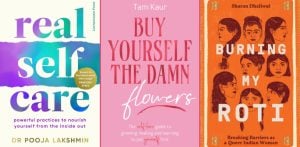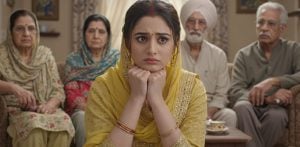"I think it's the sensible thing to do in this economy."
Thrifting in Pakistan has been present for many years. However, it has gained popularity only recently.
Better known as ‘Landa Bazar’ or ‘Sunday Bazaar’, the thrift markets in Pakistan are frequented by people from all social classes.
In 2021, Pakistan imported £142 million worth of pre-owned garments.
This impressive figure placed Pakistan as the second-largest importer of second-hand clothing globally.
The country sources these items primarily from China, the United States and Canada. The imports make it clear that the market for secondhand fashion is thriving.
Surprisingly, thrift clothing even managed to secure its spot as the 69th most imported product in Pakistan.
This indicates the growing popularity and demand for secondhand fashion within the country.
People from all walks of life are actively seeking out these pre-loved garments, recognising the value and affordability they offer.
Even though thrifting is a common practice in Pakistan, there is still a lingering sense of shame attached to it.
Many Pakistanis feel a certain level of humiliation when admitting that they buy secondhand items.
This feeling of shame might stem from societal perceptions and cultural expectations.
Moreover, the influence of media and advertising plays a role in shaping these perceptions.
DESIblitz spoke to some people from various economic and social backgrounds who frequent these secondhand markets.
We came to know various reasons why they shop there and how they feel about it.
Inflation
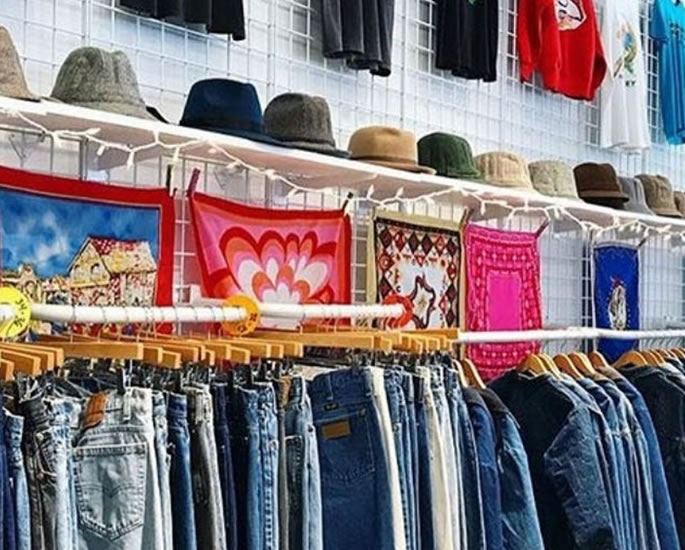
The economy plays a significant role in thrifting. Such stores provide an affordable alternative for individuals seeking quality items at lower prices.
With rising living costs and limited budgets, thrift shopping has become an attractive option for many people.
It allows them to find clothing, accessories, and household items at a fraction of the cost of new items.
Samina*, who works at a call centre in Islamabad, says:
“As a working woman, I need clothes, of course. Everything has become so expensive because of inflation.
“So I have to resort to thrifting. I think it’s the sensible thing to do in this economy.
“Why would I buy a new jacket that costs Rs. 5,000 (£14) when I can get it for Rs. 300 (85p) instead?”
Art student Miral* says: “I love dressing up and cosplaying. But I can’t do that in Pakistan without going broke. Those items are so expensive here.
“So I buy clothes and accessories from thrift markets instead.”
Dua*, an online business owner, says: “I shopped my store’s items from the second-hand furniture shop in G-9 Islamabad. It helped me save a lot of money.”
Even people from the elite class are purchasing from thrift stores now because of the economic crisis.
Psychology student Emaan explains: “I could afford new and branded clothes before. But now I can’t. So I go to Landa Bazar on a monthly basis.”
Quality
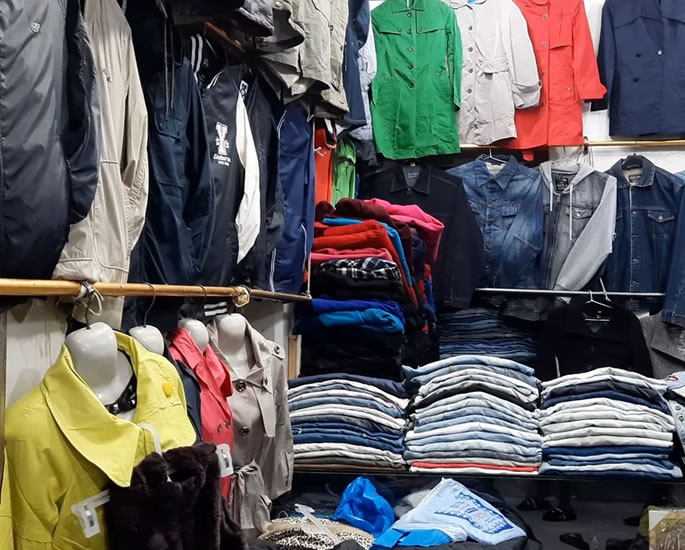
Many people claim that thrift stores offer good quality products compared to some local stores.
Thrift stores often receive donations from relatively affluent countries, neighbourhoods or individuals.
These are the people who regularly update their wardrobes or home goods. As a result, thrift markets may receive items that are still in excellent condition or even brand new.
Thrift stores typically have a high turnover of inventory, with new items constantly being donated and added to the shelves.
This means that there is a steady flow of fresh merchandise, increasing the chances of finding good quality items.
Business graduate Mubashir* says: “I have more than enough money but I fail to find quality stuff locally.
“Local items are not durable at all and local companies charge a lot.
“In thrift markets, I can find good quality stuff for less so why not?”
Sana*, a textile design student, says: “The quality and stitching of imported clothes is unmatchable.
“Take a look at the winter stuff. Local brands charge so much yet I was freezing on my tour to northern areas in one of my locally bought jackets.”
Hadia* says:
“Locally bought clothes are rarely durable. The top brands in Pakistan, like outfitters, are so expensive.”
“The ones that aren’t popular are not reliable. So thrifting is all I can do.”
Primary school teacher Nimra explained: “I have seen people from the elite class making purchases from the thrift markets as well.
“A shopkeeper was asking a woman about how her tour to Spain went, which meant she frequently visited and purchased that shop.”
The Chase for Brands

Some individuals who are brand-conscious visit thrift stores in search of specific brands or designer items at a lower cost.
Thrift stores often carry branded items that were donated, providing an opportunity for brand-conscious shoppers to find their preferred labels.
Fareeha*, a Lahore-based makeup artist, says: “Even though me and my husband both earn enough, I still think that it is silly to pay thousands just to own a branded piece.
“But I also like to wear branded clothing and so do the ladies in my social circle. So I find thrifting a better option.”
According to social media influencer Malaika*:
“Some of the brands are not easily available in Pakistan. You have to source them through different people and pages.
“And they take so long to deliver them plus they take advance payment which is not safe. Whenever I go to Landa Bazar, I easily find articles from my favourite brands like Zara, Hollister, and H&M.”
Lubna*, an army doctor says: “I love wearing branded clothes but it can be hard to style and match with every outfit.
“So thrifting gives the option of many branded clothes and accessories at reasonable prices, without any hassle.”
Sara*, a social activist states: “Some fashions are not popular here so they are unavailable. Like thigh-high boots and miniskirts. You will rarely see them in Pakistani stores.
“I want to adopt that fashion so I find them at thrift markets.”
Even Pakistani actress Fiza Ali says she has taken to thrifting.
She claimed: “I couldn’t find the shirt anywhere. It’s good so I have worn it. What’s the harm in wearing Landa?”

Why do Pakistanis feel shame for Thrifting?
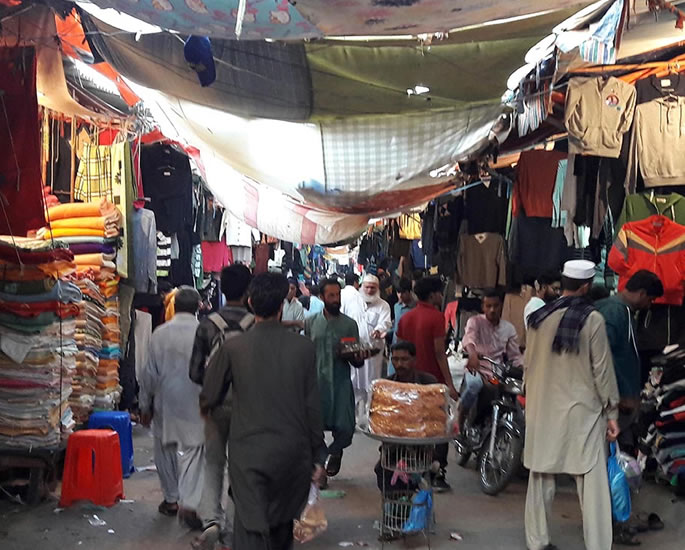
Social Stigma
In some circles, there is the belief that using second-hand items is a reflection of financial struggle or an inability to afford new things.
As a result, individuals may feel judged for not adhering to the societal norm of purchasing brand-new products.
Khalida* says: “In our society, people often equate brand-new items with social status. Admitting to thrifting might make others think I can’t afford new things.”
Business student Hassan* states: “Thrifting is seen as a last resort for those who can’t keep up with the latest trends. I don’t want people to think I’m not successful.”
Mehreen* explained: “There’s this pressure to always look polished and well-off.
“Buying second-hand items might be misinterpreted as a sign of financial struggle.
“And I don’t want people to make assumptions about my life.”
Media Perceptions
The relentless promotion of new and luxurious fashion brands creates an aspirational image that people strive to emulate.
Consequently, admitting to buying secondhand items can be seen as a deviation from this idealised image, leading to feelings of embarrassment.
Farhan*, a young writer says: “Fashion ideals often prioritise newness and exclusivity.
“Engaging in thrifting might be seen as uncool, which can make people feel ashamed to admit they do it.”
Fashion blogger Sara* admitted: “We are bombarded with images of celebrities and influencers wearing expensive and brand-new clothes.
“It creates a perception that anything less than that is not good enough.”
Abdullah*, an NGO worker says: “Media and social media play a significant role in shaping our perceptions of fashion.
“Admitting to thrifting might make others question the sense of style or whether one can keep up with the latest trends.”
Cultural Expectations
Thrift stores and the concept of thrifting may not be as prevalent in certain areas of Pakistan.
This limited exposure and awareness can contribute to a lack of acceptance.
People don’t understand the value and benefits of thrifting as a sustainable and affordable fashion option.
Ayesha*, a psychotherapist says: “In our culture, appearances matter a lot.
“Buying second-hand items might be seen as a reflection of not meeting societal expectations of always looking brand new and pristine.”
College student Saad revealed: “We are expected to present ourselves in a certain way, especially during special occasions and events.
“Admitting to thrifting can be seen as not living up to those expectations.”
Meanwhile, fashion enthusiast Zainab* said:
“There’s a common belief that using second-hand items implies a lack of taste or style.
“I don’t want people to question my fashion choices or think I’m not trendy.”
Naimal*, a film student, says: “If I admitted that I thrift clothes, people will start judging me and think that every outfit is thrifted. Which it’s not.”
Despite being common, thrifting in Pakistan faces unjustified shame. People in the H-9 thrift bazaar were mostly seen with a face mask on.
This was most probably an attempt to make sure no one they knew would recognise them.
The negative perception associated with thrifting is the reason why there are no small-scale thrift shops in Pakistan.
There are only large bazaars which are focused on one area only such as the H-9 sector in Islamabad.
Thrifting allows individuals to embrace their style, find unique items and contribute to reducing waste.
Through understanding and awareness, it is hoped that thrifting will be celebrated rather than shamed in Pakistan.





